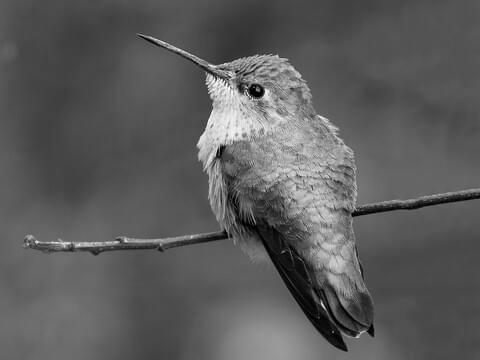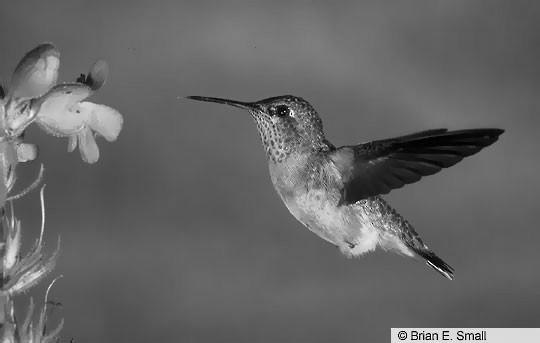Calliope Hummingbird
a Profile
Calliope Hummingbird (Stellula calliope)
The smallest bird in averages 3 inches in length.
The birds size and the male’s, sparkling ray like magenta feathers streaked with white, make for an elegant, yet unique gorget. These physical features help to identify this hummer of the mountainous regions.
Aside from the gorget, the male is very much like the female, iridescent green above, cinnamon buff along the sides, and whitish below.
Calliope hummingbirds spend the brief summer in the higher elevations of the Rockies up to 11,500 feet.
Its range extends from Central British Columbia and , to Colorado, Utah, southern California and .
The Calliope winters in Mexico and is less likely than other western humminbirds to stray to the in the fall, though numbers seem to be increasing.
During migration, the Calliope times its flight with the blooming season of favorite flowers.
migration will take familiar paths along the Pacific coast,
They use the mountains for breeding ranges and taking advantage of the late summer blooms as a return migration route.
These hummers are one feisty bird, often chasing other hummers much larger than themselves.
Relatively quiet birds, they make a soft «tik» while feeding.
The male Calliope hummingbirds Has established a territory near meadows and thickets. will do a «U» shaped display accompanied by a metallic «tzing» meant to dazzle a prospective mate.

The magenta gorget feathers of the male Calliope hummingbird are extended to catch the sun.
A flat «bxt», produced at the lowest point of the flight, is probably produced by wing or tail feathers.
After mating, the female Calliope build her nest.
Showing no particular preference for either conifers or deciduous trees, she nests at the edge of mountain streams and adjacent meadows.
Often she will build her nest on top of the previous year’s nest.
There are sometimes four story nests built by the same bird over a four year period.
Nests are constructed of bark, leaves, moss, plant down and other materials that are secured with spider silk.
The nests blend in so well, they are often mistaken for pine cones or a knot on a branch.
Snug and well insulated, they are designed to protect the female and her precious packages from the cold of the higher elevations.
As with all hummingbirds, Calliope lay two eggs.
Unpredictable falls and frigid winters dictate an early departure for fall migration.
Similar species:
The smallest American hummingbird, females are best separated by their short tail and small size.
The rufous wash on the flanks should safely separate females and immatures from all species except the three Selasphorus hummingbirds, which all typically have more rufous in the tail.
The streaked gorget of adult males should make them instantly identifiable. Calliope is the only species where the tail does not extend past the wings when at rest.

Length: 2.75 to 3.25 inches
Very small hummingbird
Relatively short tail does not extend past wings at rest.
Relatively short bill.
green back and crown.
underparts
Adult male:
Gorget composed of purple-red streaks on white background
Greenish flanks
Dark tail without white tips
Female/Immature:
chin and throat with thin dark streaking.
underparts with pale salmon wash on flanks.
Dark tail with a trace of rufous color and white tips on the outer tail feathers.
Migration Status: Neotropical migrant
Breeding Habitat: Woodland
Clutch Size: 2

Length of Incubation: 15-16 days
Days to Fledge: 18-23
Number of Broods: 1 possibly 2
Diet:
Exclusively:
Nectar
Insects
Range Map
Return to the top of page Calliope hummingbird profile
Hummingbird Species Profiles
Migration
Hummingbirds Mating
Migration
Hummingbird
Hummingbird Feeders
Enter your search terms Submit search form
Web
gardening-for-wildlife.com
Enter your E-mail Address
Enter your First (optional)
Then
’t worry — your e-mail address is totally secure.
I promise to use it only to send you Gardening For Wildlife.
